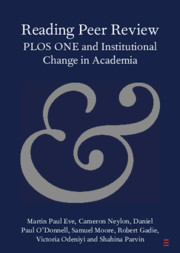Refine search
Actions for selected content:
21 results
6 - A Republic of Medical Letters and Professional Unity
-
- Book:
- Palestinian Doctors
- Published online:
- 12 September 2025
- Print publication:
- 02 October 2025, pp 178-213
-
- Chapter
- Export citation
11 - Considering the effect of bias and confounding
- from Part 6 - Decision-making
-
- Book:
- Introduction to Epidemiology for the Health Sciences
- Published online:
- 28 May 2025
- Print publication:
- 24 April 2025, pp 316-347
-
- Chapter
- Export citation
Chapter 6 - Visual Culture
- from Part II - Aesthetic and Cultural Contexts
-
-
- Book:
- Gerard Manley Hopkins in Context
- Published online:
- 16 January 2025
- Print publication:
- 16 January 2025, pp 51-59
-
- Chapter
- Export citation
Exposing linguistic imperialism: Why global IR has to be multilingual
-
- Journal:
- Review of International Studies / Volume 50 / Issue 6 / November 2024
- Published online by Cambridge University Press:
- 04 January 2024, pp. 943-964
- Print publication:
- November 2024
-
- Article
-
- You have access
- Open access
- HTML
- Export citation
The BJPsych: your journal, your voice, your research, your choice
-
- Journal:
- The British Journal of Psychiatry / Volume 223 / Issue 5 / November 2023
- Published online by Cambridge University Press:
- 01 November 2023, pp. 499-500
- Print publication:
- November 2023
-
- Article
-
- You have access
- HTML
- Export citation
The Guide to Knowledge: The Journal Rahbar-i Dānish and Its Role in Creating a Soviet Tajik Literature (1927–1932)
-
- Journal:
- Iranian Studies / Volume 55 / Issue 3 / July 2022
- Published online by Cambridge University Press:
- 14 July 2022, pp. 653-674
- Print publication:
- July 2022
-
- Article
- Export citation
Chapter 13 - Life Writing
- from Part II - Literary Forms
-
-
- Book:
- The Cambridge Companion to British Romanticism and Religion
- Published online:
- 01 October 2021
- Print publication:
- 21 October 2021, pp 217-234
-
- Chapter
- Export citation
Global trends of antibiotics research: comparison using network analysis to map the tendencies of antibiotics in water, soil and sediment
-
- Journal:
- Earth and Environmental Science Transactions of The Royal Society of Edinburgh / Volume 112 / Issue 1 / March 2021
- Published online by Cambridge University Press:
- 06 May 2021, pp. 51-60
- Print publication:
- March 2021
-
- Article
- Export citation

Reading Peer Review
- PLOS ONE and Institutional Change in Academia
-
- Published online:
- 01 January 2021
- Print publication:
- 04 February 2021
-
- Element
-
- You have access
- Open access
- HTML
- Export citation
8 - Establishing Material Platforms in Literary Culture in the 1930s and 1940s
- from (I) - Global Locals
-
-
- Book:
- The Cambridge History of Black and Asian British Writing
- Published online:
- 19 December 2019
- Print publication:
- 16 January 2020, pp 132-147
-
- Chapter
- Export citation
Open Access and Academic Journals in Canada: A Political Science Perspective
-
- Journal:
- Canadian Journal of Political Science/Revue canadienne de science politique / Volume 52 / Issue 4 / December 2019
- Published online by Cambridge University Press:
- 23 December 2019, pp. 903-922
-
- Article
-
- You have access
- HTML
- Export citation
Chapter 23 - Plath’s Journals
- from Part VI - Biographical Contexts
-
-
- Book:
- Sylvia Plath in Context
- Published online:
- 03 August 2019
- Print publication:
- 22 August 2019, pp 245-254
-
- Chapter
- Export citation
Chapter 30 - Plath in Devon: Growing Words Out of Isolation
- from Part VII - Plath and Place
-
-
- Book:
- Sylvia Plath in Context
- Published online:
- 03 August 2019
- Print publication:
- 22 August 2019, pp 317-326
-
- Chapter
- Export citation
Chapter 5 - Seeing the Divine in the Commonplace: George Eliot’s Paranaturalist Realism (1856–1859)
-
- Book:
- The Divine in the Commonplace
- Published online:
- 06 July 2019
- Print publication:
- 18 July 2019, pp 168-205
-
- Chapter
- Export citation
2 - Political Science and Energy
- from Part I - Multidisciplinary Perspectives
-
-
- Book:
- In Search of Good Energy Policy
- Published online:
- 10 June 2019
- Print publication:
- 20 June 2019, pp 25-31
-
- Chapter
- Export citation
Part I - Multidisciplinary Perspectives
-
- Book:
- In Search of Good Energy Policy
- Published online:
- 10 June 2019
- Print publication:
- 20 June 2019, pp 23-98
-
- Chapter
- Export citation
Assessment of Journals Used by Agricultural Economists at Land-Grant Universities
-
- Journal:
- Journal of Agricultural and Applied Economics / Volume 16 / Issue 1 / July 1984
- Published online by Cambridge University Press:
- 28 April 2015, pp. 167-172
-
- Article
- Export citation
Ethical Issues Faced by Editors and Reviewers
-
- Journal:
- Management and Organization Review / Volume 7 / Issue 3 / November 2011
- Published online by Cambridge University Press:
- 02 February 2015, pp. 481-493
-
- Article
- Export citation
The Impact Factor Fetishism
-
- Journal:
- European Journal of Sociology / Archives Européennes de Sociologie / Volume 54 / Issue 2 / August 2013
- Published online by Cambridge University Press:
- 18 October 2013, pp. 327-356
-
- Article
- Export citation
Parochialism or Self-Consciousness? Internationality in Medical History Journals 1997–2006
-
- Journal:
- Medical History / Volume 55 / Issue 4 / October 2011
- Published online by Cambridge University Press:
- 17 May 2012, pp. 523-538
-
- Article
-
- You have access
- Export citation
